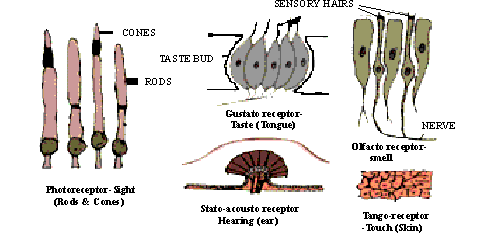|
PinkMonkey Online Study Guide-Biology
23.3 Receptors And Effectors
Sense organs make an animal aware of conditions
or events in its own body and in the world around it. Information
collected by sense organs is passed to the nervous system, which
determines and initiates an appropriate response. The stimuli
or the sensations are received by the nerves which are
associated with special sensory cells called receptors (Figure
23.7). Impulses from the receptors reach the brain (Central Nervous
System), where they are interpreted or analyzed, following which
a proper command is given to the effector organs. The effector
organs are usually muscles or glands which contract or secrete chemicals
producing suitable responses.
In higher animals, different types of cells (receptor
cells) receive a variety of stimuli. These receptor cells are grouped
together to form a sensitive structure known as sense organs.
Generally, five senses are known in higher animals. These are, sense
of touch, smell, taste, hearing and
sight. A particular sense receptor or a sense
organ is specialized and responds to only one kind of stimulus.
The main types of receptors, functions and locations are given in
following table:
| S.No. |
Type |
Function |
Location |
| 1 |
Mechanoreceptors |
Sensitive to tactile
stimuli : vibrations or pressure change and sound |
Skin and ears |
| 2 |
Thermoceptors |
Sensitive to thermal
or pressure changes and sound. |
Skin |
| 3 |
Chemoreceptors |
Sensitive to concentrations
of chemicals intensity and wave-length of light. |
Tongue, olfactory chambers |
| 4 |
Photoreceptors |
Sensitive to change in
in the internal and external environment |
Eyes |

Click here for enlargement
Figure 23.7 Various receptors
[next page]
|
Table of Contents
23.0 Introduction
23.1 Central nervous system
23.2 The automatic nervous system
23.3 Receptors and effects
23.4 Reflex action - mechanism of nervous action
Chapter 24
|